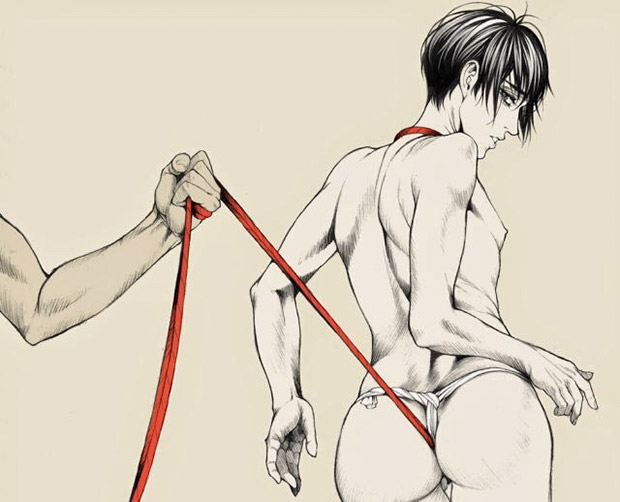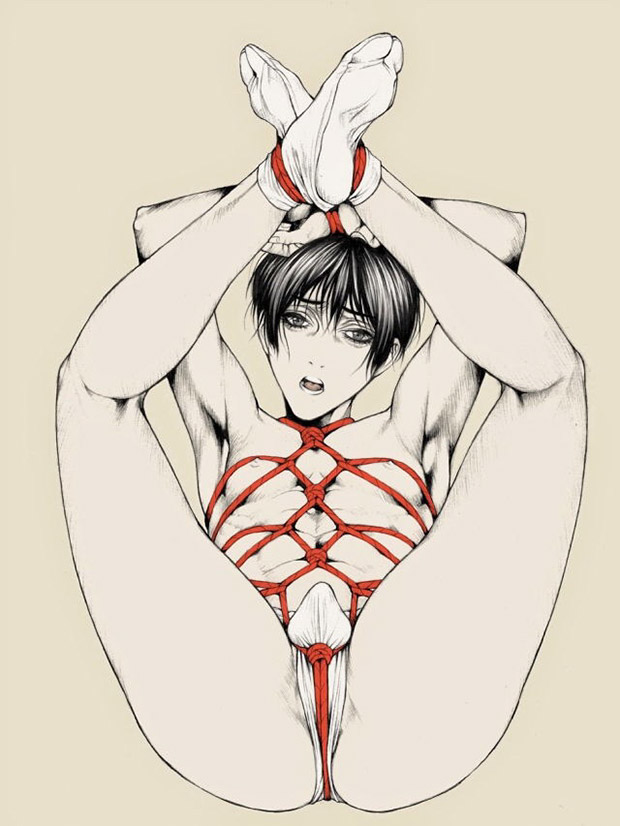By Morgan
IS IT HOJOJUTSU, SHIBARI OR KINBAKU?
The most widely used term for Japanese rope bondage now is “shibari”, which is actually a (correct) alternative pronounciation of the Japanese written characters for Hojojutsu. The same Japanese character can be read in different ways, and Shibari and Hojojutsu (捕縄術) both look the same when written.
You might also hear it referred to as Kinbaku, Torinawajutsu or Nawajutsu (nawa is the Japanese word for rope), and there is ongoing debate in the rope bondage world about the terms and whether they have precise and distinct meanings.
One modern distinction which is gaining popularity among westerners wanting to distinguish the terms is that shibari refers to purely artistic, aesthetic rope, whilst kinbaku refers to the artistic, connective, sensual, sexual practice as a whole.
Wikipedia – Japanese Bondage
For historic purposes, we’re using the term Hojojutsu in this article, but we’re talking about the same thing as Shibari or Kinbaku. Hojojutsu is actually a traditional Japanese martial arts practice using rope to restrain a person, and it is usually learned as part of a larger school of martial arts, such as Budo or Jujitsu. It’s the origin of what has developed in BDSM into more erotic ties and practices.
ROPE BONDAGE AND JAPANESE CULTURE
Many of us are familiar with the Western style rope ties which enable a prisoner to be restrained with the use of ropes or, more recently, plastic ties. Not so familiar are the Japanese methods which have been in existence since at least the Fifteenth Century, and whose codes were written down in a highly structured manner.
I first became aware of Japanese rope ties when Maurice (Jim) Stewart of Fetters asked me to help him copy a catalogue of designs by the Japanese artist Go Mishma. These depicted oriental bodies adorned with tattoos and restrained by rope ties unlike the standard western hog tie or spreadeagle. We recruited a model and made some photos of the positions and the ties which I believe were subsequently made public. I was intrigued and have, over the years, attempted to find out more.
It’s not easy to find out information about Japan. The language is one barrier, the culture and the geography—not en route to a popular holiday destination—is another. However, there is in Japan currently a large and flourishing gay culture mainly centred on bars and sex clubs. Many Japanese still live in the same apartment with their parents, an arrangement enforced by the high urban property prices and which also reduces the likelihood of playing at home for gays or straights.
BDSM practices appear to flourish, but it seems that Westerners are unwelcome—yes, actually unwelcome—except at the bars specifically intended for mixing between Japanese and foreigners. And these are not the BDSM bars.
It seems that part of the problem is the legacy of the Yuko Mishima incident of 1970 when the author committed ritual suicide as a consequence of the rejection by the Japanese government of his campaign to restore traditional cultural values to Japan.
Although it seems that there are political groups of the far-right in contemporary Japan, as there are in other democracies, to be seen to be in any sense aligned or confused with them is as impossible to politically correct modern gay Japanese. Sm culture or gay culture which places too high a value on traditional values—such as Samurai—are currently too close for comfort. Martial Arts (Ju-jitsu and so on) escape this censure by being “sporty”.
There is another to this as well—Martial Arts preserve their culture by passing it from master to committed disciple. Outsiders do not need to know the secret skills and ways. If you wish to learn Akido, you must go to an Akido gym and endure the course which will probably start you at the bottom of the social ladder and have you cleaning the showers at the end of a session.
Before getting too judgmental about Japanese culture, its self-restrictions, xenophobia and fascism, it is perhaps salutary to remember that Tom of Finland’s style originated from his drawings of Nazis in uniform and it took many years for his fantasies to become as central as they have now become to the leather culture.
In mainland Japan, the Samurai warriors were the local rulers during the Edo period (1600-1868). This was a time of relative prosperity and stability. This included legal ritual love between man and boy. The Samurai organised their territories in feudal hierarchical manner, which included the organization of law and order.
Great value was placed on rank and culture within this society and therefore deprivation of an individual’s freedom bore great stigma. A distinction arose between restraint by rope and knots which was disgraceful, and restraint by rope and silk wrap which was not disgraceful.
One method which allowed an efficient (i.e. inescapable) tie to be applied without using knots was to form a loop or a hook on one end of the rope and to leave the trailing end long but attached elsewhere. This did not provide maximum security, but allowed a suspect, for example, to be transported or supervised at a reasonable level of security considering the cultural sensitivities.
THE TRADITIONS OF SHIBARI
The art of using rope to capture, restrain and transport suspects and criminals was known as Hojojutsu.
The colour of the rope used bore a significance —initially different colours for different seasons, but later this was changed to different colours for different branches of the constabulary. In other areas, it seems different colour ropes were used for different classes of prisoner. The direction that the prisoner was faced when restrained also changed according to the season.
There were four rules of Hojojutsu:
- Not to allow the prisoner to slip his bonds.
- Not to cause any physical or mental injury.
- Not to allow others to see the techniques.
- To make the result beautiful to look at.
The practice continues to this day —the Japanese National police still carry the 1.8 metre rope (“hayanawa”) and use it for restraining suspects, particularly when drunk or under the influence of other drugs. It seems to be as rapid and effective as applying slap-on handcuffs. Until you have it applied to you, I don’t think you will believe just how effective it can be.
Additionally, a long rope was used to link prisoners, or to establish a more elaborate tie on a prisoner. My experience shows that these also are devastatingly effective and make most of the rope ties seen in porn seem inelegant and easily escapable.
THE TORTOISE
My own first introduction to ropes was to the body harness that I now know as the “tortoise-shell”. I am no clearer as to its origins but to offer the rumour I heard that it was a religious penance and that each of the carefully placed knots had a particular significance. Variations on the general them can be seen in contemporary Japanese pornography where it is used on a sub in a similar way to a leather harness in the West. The “tortoise-shell” will also retain a butt-plug or other dildo.
Again it appears unchallenging when first applied, but the sensation builds inexorably. It can be worn under clothes or can be the basis for restraints to a fixed object.
This tie contains many knots and I understand them to each have a ritual significance. But, I have not yet found anyone who can describe that.
The sensation when wearing it is initially of constraint, breathing becomes slightly more difficult as you have to labour against the rope as it expands within its shape.
You find that the ropes fall, not on pressure points, but on aggravating places —the shoulders, under the arms and in the groin. As you wear it for longer, these become uncomfortable, but impossibly so in any individual location. Any place where the rope is touching the skin becomes red, but you don’t feel the effect of this until you have been stationary and then move.
The knots are even more aggravating. It turns out that they do each have a different character —the one in the middle of the chest bears on the breastbone, those in the stomach dig into stomach muscles; the knot on the anus keeps a plug in place or is itself the dildo that makes itself felt you make wind.
The discomfort is cumulative and not catastrophic; this is a harness to wear for an evening out, and to keep on for the night. Taking it off becomes an immense relief. But, also, you feel cold!
Incidentally, I wash the rope by tying it in a t-shirt and using a short wash cycle.
THE GUN
Another tie with BDSM applications is called “The Gun” in Japanese. Here the hands are clasped together and tied at the prisoner’s neck. It doesn’t need much rope and it is truly inescapable. With the feet tied as well, the prisoner is immobile and helpless. This position is recommended for prisoner of war interrogation situations. It takes a surprisingly long time for the hands to go really numb and the prisoner is helpless against attack to his stomach (punches), feet (tickling or bastinado; yes, the Japanese used bamboo staves for that), or armpits. Fire and Water torture were also used as well.
THE SHRIMP
“The Gun” is an interrogation position, but “The Shrimp” (the Ebi tie) is a torture position. You don’t need to do anything more than to put the prisoner in the position and wait for him to start yelling. The prisoner sits cross-legged and his feet are tied together. His arms are tied together in a harness behind his back.
So far no torture. The harness behind the back is now pulled by rope to the feet; it may be necessary to use some force to bend the prisoner over, especially if he knows the position. The feet tie is now secured to the arm tie and the prisoner’s back is bent over. The pain is like a neck to collar tie, plus back bending, plus stomach squashing, plus knee cramp, plus thigh cramp. Effective.
Left sitting, the prisoner will wriggle and probably try to roll onto his side. This will make the discomfort worse. Take care he cannot hit his head. You have the option of rolling him onto his shoulders which gives you access to his buttocks, arsehole, testicles and cock.
Finally, gags. Rope makes an effective gag if you bind round the open mouth to the neck. Just do it and the prisoner won’t be able to dislodge it. You can stuff a jock or sock inside as well.
A few mentions on the practical side —cotton or hemp rope is the best. Nylon slips and cuts. The sort sold as cord for sash windows suits my purposes fine, but you have to wash it before use as it can contain silicones to help it in its original intended use.
When applying the ropes to your sub’s body, unless you specifically want to create a rope burn, don’t pull rope through knots at even moderate speed when the rope is in contact with his skin. Rope burn occur easily and heal slowly.
One knot in the right place is better than lots of knots all over the place – more secure, prettier, quicker to untie in an emergency.
You only need one turn around the wrists or whatever you are trying to secure. If you use several turns, you make it more difficult for the prisoner to creep the tie and escape (this is what is usually suggested for Western type ties). However, Hojojutsu ties are inherently more secure, so you only need one turn. One turn looks neater, but you must be careful to judge it so that it is not so tight as to restrict circulation.
USEFUL BOOKS
• Partings at Dawn: An Anthology of Japanese Gay Literature (12th to 20th Century), edited by Stephen Miller
• Shibari You Can Use by Lee Harrington and RiggerJay
• More Shibari You Can Use by Lee Harrington and RiggerJay
• The Seductive Art of Japanese Bondage by Midori and Craig Morey
• Showing You The Ropes by Two Knotty Boys
• Back on the Ropes by Two Knotty Boys
FURTHER READING
• Deviance & Desire – How Japanese Rope Bondage Culture Developed Outside of Western BDSM
• Houdini Connections – Hojo-Jutsu or Shibari
• FetLife – Shibari
• FetLife – Japanese Rope Art – Kinbaku – Shibari
• FetLife – Riggers and Rope Sluts
• Crash Restraint – Shibari News, Ties, Photos and Advice
• Ropemarks – Glossary of Japanese Bondage Terms
• Twist of Wyrd – The Art and History of Erotic Bondage
• RopeTopia – Rope Bottom Guide
• YouTube – The Ebi Tie
• Japanese Rope Art – History & Style: East versus West
ABOUT THE AUTHOR
 Writer and photographer Morgan is author of More and Harder, a fictional erotic autobiography of Mark, an English sadomasochist. He was the author of many articles in the now-defunct Checkmate Magazine.
Writer and photographer Morgan is author of More and Harder, a fictional erotic autobiography of Mark, an English sadomasochist. He was the author of many articles in the now-defunct Checkmate Magazine.
Checkmate was an influential gay BDSM journal from 1998 to 2003.
This article first appeared in S/M Perspectives (Vol 2, Issue 2), independently published in Vancouver by Rainfall Press.



2 Comments Add yours